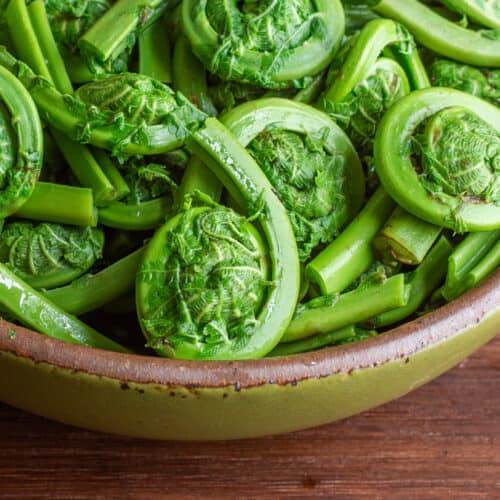Fiddlehead Fern A Timeless Botanical Wonder
The existence of Matteuccia struthiopteris (Fiddlehead Fern) spans thousands of years and is deeply embedded in early civilization life and native customs. The origins of this plant can be seen in ancient temperate forests across North America, Europe, and Asia where it prospered in moist shaded woodland areas. Ancient fossils demonstrate that the predecessors of this plant thrived during prehistoric periods before humans began agricultural activities.
The earliest documentation of this species comes from North American indigenous people who valued it as both sustenance and medicine. European settlers admired its distinctive structure and lush appearance which led them to add it to their gardens and meals. During the 18th and 19th centuries botanists completed formal classification for this species while acknowledging its ecological benefits and usefulness in horticulture. The species currently stands as a testament to durability and aesthetic value while serving practical purposes within both untouched ecosystems and designed landscapes.
Fiddlehead Fern Traditional and Modern Medicinal Uses
Matteuccia struthiopteris has maintained its value as a medicinal plant for hundreds of years. Indigenous healers prepared teas and poultices from the plant's young shoots and roots to help digestion while reducing inflammation and easing arthritis symptoms. Because of its antioxidant content along with essential vitamins and minerals it gained recognition for boosting immune strength and enhancing health vitality.
Modern herbal practitioners conduct ongoing research to uncover its potential health benefits. Scientific studies indicate that its compounds have antimicrobial properties that assist in fighting minor infections. Its detoxifying effects make it a popular choice for natural treatments designed to purge toxins from the body. Traditional healing practices acknowledge its historical significance which allows this botanical remedy to retain respect despite being a secondary focus in modern medicine.
Discovery and Early Documentation
European botanists formally recorded Fiddlehead Fern in scientific literature during the 17th century despite its long-standing use by indigenous peoples. The early adventurers who passed through North American forests observed the plant's remarkable appearance and fast seasonal development. Botanical specimens were shipped to European gardens for research into their ability to adapt to new environments and their potential as decorative plants.
Plant collectors introduced the species to cultivated landscapes during the 19th century because they wanted to add lush vegetation that thrives in shaded environments. The plant's proficiency at growing in cool and moist locations led to its common use in Victorian gardens beside water elements and shaded pathways. As time passed its status as a resilient and attractive plant established its enduring presence in horticultural practice.
Fiddlehead Fern A Stunning Addition to Landscapes
Landscape designers highly value Matteuccia struthiopteris for its capacity to produce dense naturalistic displays. The towering feathery fronds of this plant dramatically open to form elegant vase-like clusters that provide dynamic texture for shaded gardens.
Gardeners often choose this species for woodland areas because it pairs well with native wildflowers and other plants that require moist soil conditions. Gardeners value its dense ground cover properties which help prevent soil erosion in runoff-prone areas. This plant flourishes near pond borders and stream edges and shaded borders where its vibrant green leaves stand out against darker structured plants.
Shade gardens in city areas frequently utilize this plant to add lively green spaces within courtyards and beneath trees. Landscapers choose this plant because its minimal care requirements help them achieve an organic look and support local ecosystems.

A Striking Botanical Marvel
Fiddlehead Fern stands out with its seasonal appearance transformations. At the beginning of spring, tightly coiled emerald-green shoots rise from the earth, and they take on the appearance of fine spirals. These juvenile fronds begin curled but gradually open up to become graceful arching leaves that extend to impressive heights.
The plant's feathery foliage creates a lush tropical atmosphere during summer's peak as it sways gently in the breeze. The plant maintains its vibrant green color through the summer but starts showing golden tones during the autumn before fading to match the winter season. During winter dormancy dried fronds remain as sculptural features in landscapes while giving protection to small animals underneath snow cover.
Fiddlehead Fern A Haven for Rare Wildlife
The fern Matteuccia struthiopteris serves as an important foundation for supporting wildlife species that require shaded, moist surroundings to survive. Amphibians such as salamanders and frogs find effective protection from predators within the protective embrace of dense foliage clusters.
The existence of this plant attracts pollinators and beneficial insects because it helps maintain a balanced ecosystem. Some moth and butterfly species choose to deposit their eggs under the plant's fronds which provides a protected space for their young to grow.
Birds and small mammals sustain themselves through the year because the rich organic matter beneath their canopy produces insects and decomposing plant material. The microhabitats it creates serve as critical resources for conservation-focused gardeners who want to support local wildlife populations.
Resilience in Diverse Climates
Fiddlehead Fern shows exceptional durability as its defining characteristic. The plant flourishes across USDA zones 3 to 7 because of its impressive resistance to cold temperatures.